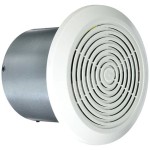How To Get Rid Of Sewer Gas Smell In Bathroom
The presence of sewer gas in a bathroom is a serious issue that requires prompt and effective resolution. Sewer gas, a complex mixture of toxic and non-toxic gases, is produced during the decomposition of organic waste. Prolonged exposure, even at low concentrations, can lead to health problems, ranging from mild discomfort to more severe conditions. Identifying the source of the sewer gas smell is crucial for implementing the appropriate remedial actions. This article details the common causes of sewer gas odors in bathrooms and outlines a systematic approach to eliminating them.
Identifying Potential Sources of Sewer Gas
The first step in resolving a sewer gas issue is to pinpoint the most likely sources. Several components of a bathroom's plumbing system are designed to prevent sewer gas from entering the living space. When these components malfunction or become compromised, sewer gas can escape. Thorough inspection and understanding of these elements are essential for accurate diagnosis.
The most common culprit is a dry drain trap. Plumbing fixtures, such as sinks, showers, and toilets, utilize P-traps, which are curved sections of pipe designed to hold water. This water barrier prevents sewer gas from flowing back up the drainpipe and into the bathroom. If a fixture is not used regularly, the water in the trap can evaporate, creating an open pathway for sewer gas. Infrequently used guest bathrooms are particularly vulnerable to this problem.
Another potential source is a cracked or damaged drainpipe. Over time, pipes can corrode, develop cracks, or become dislodged due to shifting foundations or other structural issues. These breaches allow sewer gas to leak directly into the bathroom. Careful examination of exposed piping underneath sinks and around toilets can reveal visible damage. Evidence of water stains or dampness near pipes can also indicate a leak, even if the crack itself is not immediately apparent.
A faulty toilet wax ring is a frequent source of sewer gas odors. The wax ring creates a seal between the toilet base and the drainpipe flange on the floor. This seal prevents water and sewer gas from escaping around the base of the toilet. Over time, the wax ring can dry out, crack, or compress, compromising the seal. Signs of a failing wax ring include a wobbly toilet, water leaking around the base of the toilet, or a persistent sewer gas smell emanating from the area.
Ventilation systems are also crucial for preventing sewer gas buildup. Plumbing systems incorporate vent pipes that extend from the drain lines to the roof of the building. These vents allow air to enter the drain system, preventing a vacuum from forming that could siphon water out of the P-traps. Blockages in the vent pipe, such as bird nests or debris, can disrupt the airflow and cause sewer gas to be drawn back into the bathroom through the drains.
Another potential, although less common, source of sewer gas is the sewage ejector pump. These pumps are typically found in basements or below-grade bathrooms, where gravity cannot adequately carry wastewater to the main sewer line. If the ejector pump's vent is improperly installed, damaged, or clogged, it can release sewer gas into the bathroom. Additionally, a leaking or malfunctioning pump can also contribute to the problem.
Remedial Actions for Sewer Gas Odor Elimination
Once the potential source of the sewer gas odor has been identified, the appropriate corrective measures can be implemented. The specific actions required will depend on the underlying cause of the problem. Addressing the issue promptly is important not only for eliminating the unpleasant odor but also for preventing potential health risks associated with sewer gas exposure.
For dry drain traps, the simplest solution is to replenish the water in the trap. Run water down the drain for several minutes to ensure that the trap is completely filled. If the fixture is not used frequently, periodically running water down the drain can prevent the problem from recurring. In situations where fixtures are left unused for extended periods, pouring a small amount of mineral oil into the drain after filling the trap can help to slow down evaporation.
If a cracked or damaged drainpipe is suspected, a thorough inspection is required to confirm the extent of the damage. Minor cracks or leaks can sometimes be repaired using epoxy putty or pipe sealant. However, more significant damage may necessitate replacing the affected section of pipe. For more extensive repairs, it is advisable to consult with a qualified plumber to ensure that the work is done correctly and in compliance with local plumbing codes.
Replacing a faulty toilet wax ring is a relatively common do-it-yourself project, but it requires care and attention to detail. First, the water supply to the toilet must be shut off, and the toilet tank and bowl must be emptied. The toilet is then disconnected from the drainpipe and carefully lifted off the flange. The old wax ring is removed, and the flange is inspected for damage. A new wax ring is installed, and the toilet is reattached to the flange, ensuring a tight and level seal. It is crucial to follow the manufacturer's instructions when installing the new wax ring to ensure proper sealing.
Addressing vent pipe blockages typically involves accessing the vent pipe on the roof of the building. This can be a hazardous undertaking and should only be attempted by individuals who are comfortable working at heights and have the necessary safety equipment. Using a garden hose or a plumbing snake, the vent pipe can be cleared of debris. If the blockage is severe or difficult to reach, it may be necessary to consult with a professional plumber.
When dealing with sewage ejector pumps, it is essential to follow the manufacturer's instructions and safety guidelines. Inspect the pump's vent for any obstructions and ensure that it is properly connected to the vent system. Check the pump for leaks or other signs of malfunction. If the pump is not functioning correctly, it may need to be repaired or replaced. In some cases, professional assistance may be required to diagnose and resolve ejector pump problems.
Preventative Measures to Minimize Sewer Gas Issues
In addition to addressing existing sewer gas problems, implementing preventative measures can help to minimize the risk of future occurrences. Regular maintenance and proactive inspections can identify potential issues before they escalate and cause significant problems. These measures can contribute to a healthier and more comfortable living environment.
Regularly flushing toilets and running water down drains, especially in infrequently used bathrooms, is a simple but effective way to prevent dry drain traps. This practice helps to maintain the water barrier in the P-traps and prevents sewer gas from entering the living space. Consider implementing a schedule to ensure that all fixtures are used at least once a week.
Periodically inspecting exposed plumbing pipes for signs of damage, such as cracks, leaks, or corrosion, can help to identify potential problems early on. Addressing minor issues promptly can prevent them from developing into more significant and costly repairs. Look for water stains or dampness near pipes, which can indicate a leak even if the crack is not immediately visible.
Ensuring proper ventilation of the plumbing system is crucial for preventing sewer gas buildup. Regularly inspect the vent pipes on the roof for any obstructions, such as bird nests or debris. Trimming trees or bushes that are growing near the vent pipes can help to prevent them from becoming blocked. If you are unable to safely access the vent pipes, consider contacting a professional plumber to perform the inspection and maintenance.
Avoid pouring grease, hair, or other debris down the drain, as these materials can accumulate and cause blockages. Use drain screens to catch hair and other small particles. Periodically flush drains with hot water to help prevent grease buildup. Consider using enzymatic drain cleaners to help break down organic matter and keep drains clear.
Proper installation of plumbing fixtures is essential for preventing leaks and sewer gas odors. Ensure that all connections are tight and properly sealed. When replacing a toilet or other plumbing fixture, follow the manufacturer's instructions carefully. If you are not comfortable performing the installation yourself, consider hiring a qualified plumber to ensure that the work is done correctly.
By understanding the common causes of sewer gas odors in bathrooms and implementing appropriate remedial and preventative measures, homeowners can effectively eliminate these unpleasant and potentially hazardous conditions. Regular maintenance and prompt attention to potential problems are key to maintaining a healthy and comfortable living environment.

How To Eliminate Basement Odor And Sewer Smells Family Handyman
My Bathroom Smells Bad But Only When Its Hot Outside It Also Will Slightly Go Away I Run The Sink And Toilet Bathtub Any Thoughts On What Is

My Bathroom Smells Like A Sewer What Causes That And How Do You Fix It Kitchen Infinity
What To Do When You Notice A Sewer Smell In Bathroom Spaces Howstuffworks

Why Does My Toilet Smell Like Sewage 5 Causes Solutions

Sewer Smell In Bathroom Identify And Eliminate The Odor

How To Get Rid Of The Sewer Smell From A Bathroom Terry S Plumbing

Sewer Smell In Bathroom Solved Bob Vila

How To Eliminate Basement Odor And Sewer Smells Family Handyman

How To Get Rid Of Sewer Smell In Your House From Basements Bathroom Sinks Toilets And More
See Also







